Whether you experienced and were living in the 1950s or are just curious, Life in the 1950s: A Glimpse into Postwar Society will give you insight into some of the events, fads, and lifestyles that mark that decade.
The 1950s in America was a time encapsulated by a booming economy, a surge in the birth rate known as the baby boom, and the rise of the suburbs. During this era, the United States saw an expansion in government spending including on the military in the context of the Cold War. American society was marked by a strong emphasis on traditional gender roles, with the nuclear family at its center. Prosperity was a hallmark of the time, as was the conformity that seemed to characterize much of American life, with new homes springing up in the suburbs, complete with backyards and the expectation of a stay-at-home mom.
While American families enjoyed newfound prosperity, social trends were evolving. Teenagers became a distinct demographic, with high school experiences becoming a defining part of young American life. The growing middle class indulged in the latest consumer goods, from new cars to modern appliances, facilitated by the G.I. Bill and low-cost mortgages. Entertainment shifted as well, with television shows like “American Bandstand” becoming a staple in homes and Elvis Presley, the king of rock, revolutionizing music. The latter part of the decade began to show cracks in this idyllic facade, with the civil rights movement gaining momentum and individuals like Rosa Parks taking a stand.
Key Takeaways:
- The 1950s were characterized by economic prosperity in the United States and a cultural adherence to traditional societal roles and the nuclear family.
- American culture during the ’50s included a focus on consumer goods, the emergence of teenagers as a unique group, and significant influence from popular media and personalities.
- Despite the apparent conformity of the time, seeds of societal change were present, leading to the civil rights movement and a shift towards new social norms.
Significant Events
With World War II ending a few years before, there was a renewed spirit of hope and economic expansion in the 1950s. The decade has been referred to as the golden age, and baby boomers were arriving on the scene. By 1952 inflation had receded, and The United States was a major influential economic power.
War
The 1950s were marked by a notable military engagement on the Korean peninsula. The conflict arose from a division between the North, supported by Soviet interests, and the South, aligned with the United States. The American government saw its involvement as a stand against the spread of communism. The Korean War ended, and the Signing of the Korean Armistice Agreement took place on June 27, 1953. This drew a new border between North Korea and South Korea, granting South Korea some additional territory and demilitarizing the zone between the two.
Another defining element of the 1950s was the tension between the United States and the Soviet Union, known as the Cold War. Though military action never occurred, there was hostility between the two nations.
Rosa Parks
The civil rights movement gained momentum when an African American woman, Rosa Parks, challenged segregation in Montgomery. On a December evening in 1955, Parks’s refusal to vacate her seat to a white passenger sparked widespread action. This act of resistance led to a city-wide bus boycott and signaled to American society the beginning of a direct challenge to racial discrimination. It culminated in a 1956 Supreme Court decision that declared segregated buses unconstitutional.
Video: Life in the 1950s – A Trip Down Memory Lane
Health Breakthrough
During the 1950s, one of the most commendable healthcare advances was the introduction of the polio vaccine. A significant medical finding by Jonas Salk irradicated much of the crippling disease in the United States by way of vaccination. Schools across the United States swiftly implemented mass vaccination programs starting in 1954, with millions of doses administered by 1955 leading to a dramatic plunge in polio cases.
By 1959, 90 other countries had begun administering the vaccine. Polio is now very rare in the United States. Elsewhere in the world, there are approximately 250,000 cases of polio a year – most in countries where the vaccine is not widespread.
Scientific Progression
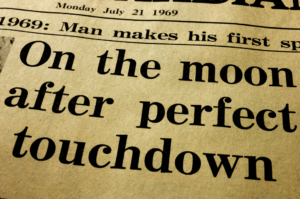
The late 1950s witnessed a monumental leap in scientific exploration with the Soviet Union’s launch of Sputnik 1, marking the inception of the space age. This period saw the establishment of NASA in 1958, intensifying the space race against the Soviet Union. Interwoven with the fabric of American society, the space race captured the imagination of young and old alike, symbolizing the quest for knowledge and the spirit of the Cold War era.
It is said the United States won the race with the Apollo 11 mission when Neil Armstrong and Buzz Aldrin landed on the moon via a lunar module called the Eagle on June 20, 1969. Neil Armstrong was the first man to walk on the moon with the famous words still heard today, “That’s one small step for a man, one giant leap for mankind.” Buzz Aldrin followed next, and the two spent about 3 hours walking around the moon. Michael Collins, the third cosmonaut, remained in orbit piloting the mother ship.
Statehood Expansions
The American map gained two stars in 1959 as Alaska and Hawaii became the 49th and 50th states. In 1867 The United States bought Alaska from Russia. In 1912 Alaska was considered a military district and was considered a territory. Since the 1920s, Alaskans had sought statehood. It was on January 3, 1959, that President Eisenhower declared Alaska the 49th state of the union.
Hawaii became an American territory in 1900. Hawaii petitioned to become a state many times during the 60 years between its being acquired as a territory and finally being allowed to become a state. On August 21, 1959, President Eisenhower signed the official proclamation admitting Hawaii as the 50th state.
Innovations in the Automotive Sector
Expansion of the Highway System in the 1950s
Your travel was transformed in the 1950s with the Federal-Aid Highway Act of 1956 (aka National Interstate and Defense Highways Act), a significant leap allowing you to drive coast-to-coast with ease. The ambitious project forged vast highways that knit the United States together, feeding into the fabric of American life by enabling cars to become a more integral part of daily life and the booming economy.
Automobiles

There were quite a few innovations that became more popular and standard in the automobile of the 1950s. Four of the major ones are:
Notable Automobile Advancements
| Feature | Impact on Cars |
|---|---|
| Automatic Transmissions | Became more common in passenger vehicles, providing ease of use compared to manual transmissions. |
| Power Steering | Introduced largely by Chrysler and Cadillac, this feature reduced the effort needed to manoeuvre vehicles. |
| Power Windows | Added convenience for drivers and passengers, reflecting the decade’s technological progress. |
| Seat Belts | Patented improvements increased safety, starting to be a standard component in new cars like the Chevrolet Corvette and Ford Thunderbird. |
Some of the new cars manufactured in the 1950s are:
- Studebaker Starliner – 1953
- Chevrolet Corvette – 1953
- Chevrolet Bel Aire – 1955
- Ford Thunderbird – 1955
- Packard – 1955
- Cadillac Coupe deVille 1959
American society of the 1950s saw a rise in car prices from an average of $1,510.00 to $2,200.00. This reflected the era’s wealth and the value placed on innovations that catered to a generation of young people who began seeing cars as a symbol of freedom and status amidst a culture celebrating figures like Elvis Presley.
The interstate highways connected communities and spread the ethos of the American dream, making it easier for families to visit new homes or travel from bustling cities like New York to the tranquil suburbs, embodying the nuclear family ideal and shaping the daily life of the American family.
Fashion
Attire for Women
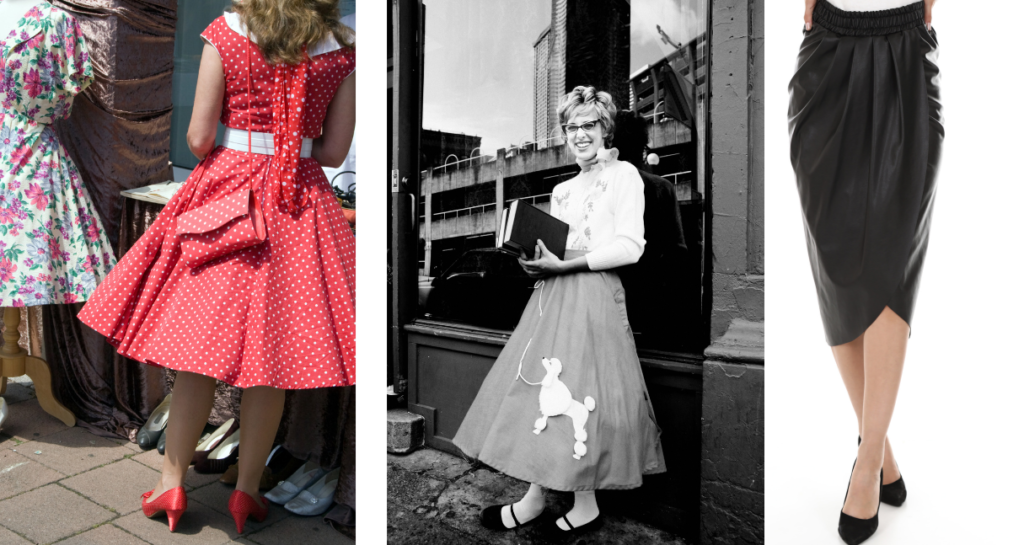
In the decade central to the baby boomer era, your wardrobe would likely consist of swing dresses that celebrated femininity. Featuring a cinched waist, these dresses flared gracefully to just above the knee, often amplified in volume by petticoats. As a young woman stepping out of a high school dance, you’d be found in a pencil skirt or a playful poodle skirt.
Attire for Men
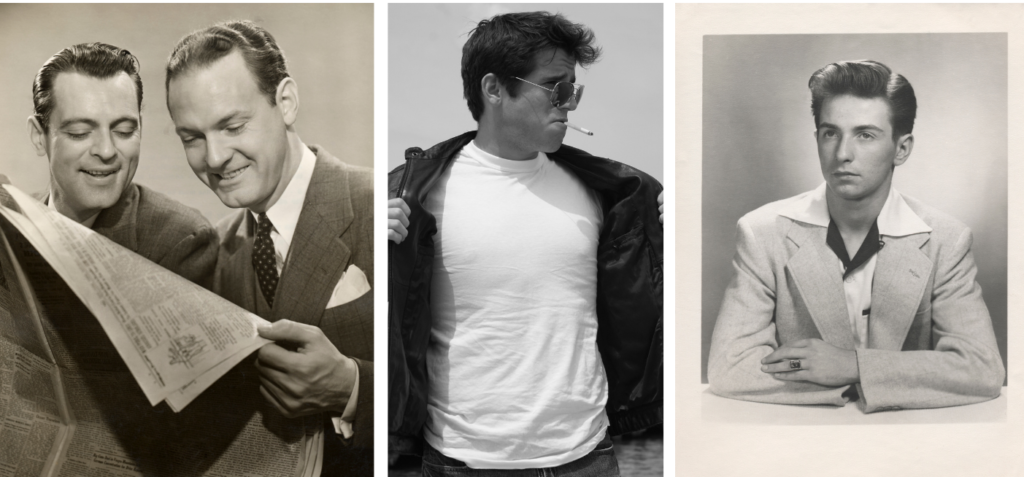
You might associate the 1950s man with leather jackets emblematic of greasers, an image that would not be out of place in T.V. shows reminiscent of the era. Despite the popularity of such casual attire, in the offices, it was the gray flannel suit that you, along with many American men, would don, a symbol of the country’s booming economy.
Footwear
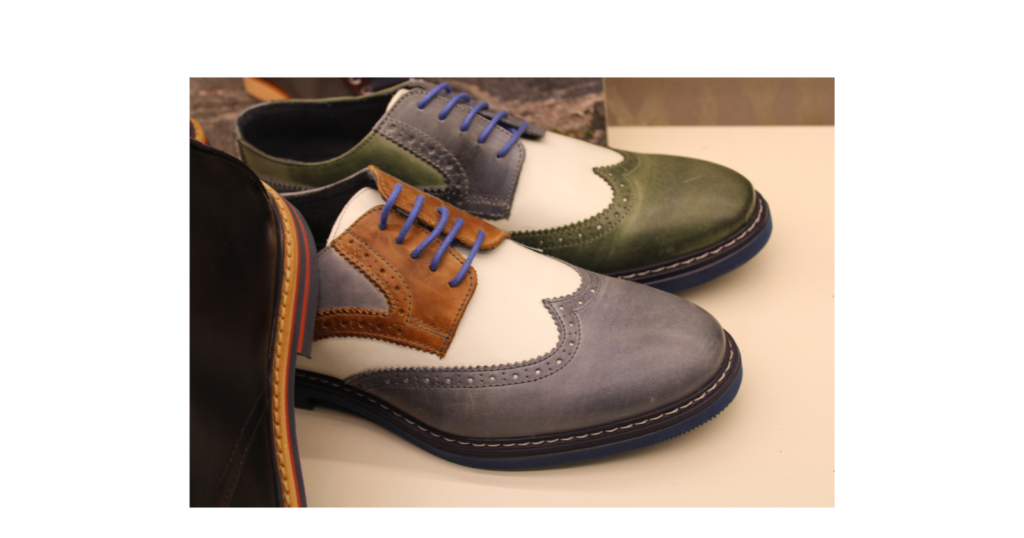
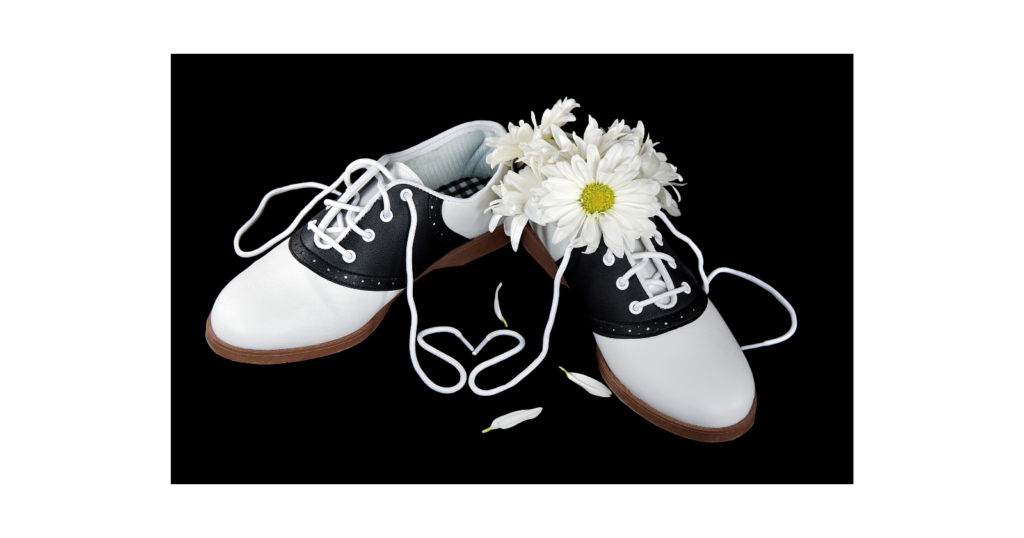

If you were to step into a 1950s middle-class American home, you’d find black and white saddle shoes paired with bobby socks. These iconic shoes were as common a sight in public schools as they were in suburban homes, marking a common style for teens and women alike.
Men, while they occasionally opted for brown and white saddle shoes, gradually shifted towards penny loafers, indicating a subtle shift in fashion trends from previous generations.
Hairstyles
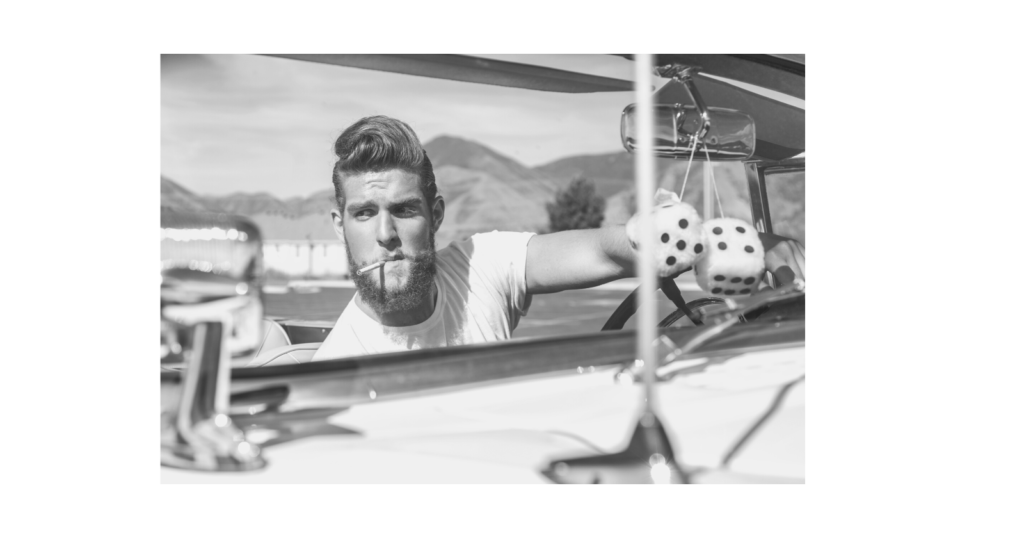
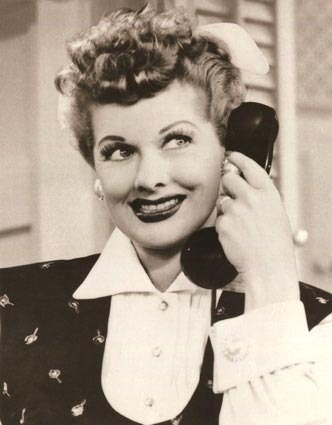
In the vibrant landscape of 1950s America, men’s hair often took shape in sleek pompadours, a style magnified by Elvis Presley, the unspoken king of rock. A neatly set side part or a crisp crewcut signified the polished look of the time.
For American women, Lucille Ball epitomized the era’s charm with her Poodle Cut. Ponytails, bouffants, and pixie cuts also made their mark, reflecting the emerging American dream—a mix of traditional roles and revolutionary changes in daily life.
Other popular women’s hairstyles in the 1950s include the classic ponytail, bouffant, soft bob, and pixie cut.
Entertainment
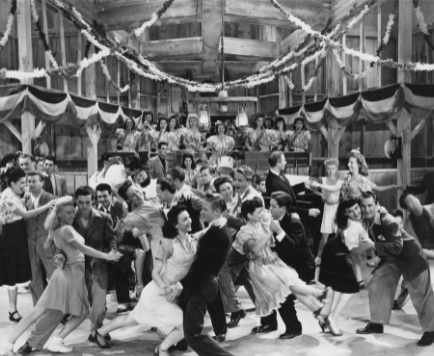
Dance
- Popular Dances Included:
- Bomba
- Bunny Hop
- Hully gully
- Madison
- Sock Hop
- The Handjive
- The Jitterbug
- The Chicken
- The Meatstick
- The Stroll
- The Twist
Music
Ballroom and Social Dancing Rhythms
During this era, you could witness a myriad of dance styles sweeping across the United States. The Bomba rhythm originating from Puerto Rico echoed through the halls, while more mainstream styles like the Bunny Hop and Sock Hop became commonplace at social gatherings. Youthful energy was channeled through the Handjive and exuberant Jitterbug, while dances like The Twist encouraged even the most reserved individuals to hit the dance floor.
Harmonic Waves of the Era
The decade brought an explosion of Rock and Roll, with Elvis Presley taking the stage as one of its pioneers, shaping the heartbeat of popular culture. Accompanied by the likes of Chuck Berry and Buddy Holly, this music genre resonated with the young and old, leaving a permanent imprint on American music history. Simultaneously, Rhythm & Blues flourished with Ray Charles and Sam Cooke adding depth to the rich tapestry of this era.
| Rock-n-Roll | Traditional | Country | Rhythm & Blues |
| Bobby Darin Buddy Holly Chubby Checker Chuck Berry Elvis Presley Fats Domino Jerry Lee Lewis Little Richard Ritchie Valens Roy Oberson The Coasters | Andy Williams Perry Como Dean Martin Doris Day Ella Fitzgerald Frank Sinatra Johnny Mathis Nat King Cole Pat Boone Perry Como Rosemary Clooney Tony Bennett | Conway Twitty Gene Autry Hank Williams Johnny Cash Patsy Cline | Ray Charles Sam Cooke The Platters |
Television
The ’50s were christened the Golden Age of Television, as the prevalence of televisions in American homes rocketed from 9% to a staggering 85.9%. Iconic shows like “I Love Lucy” and “Leave It to Beaver” took center stage, forever redefining family entertainment and bringing the American experience into living rooms across the nation.
Cinematic Spectacles
Despite the surge of television, movies persisted as a grand escape, boasting megastars such as Marilyn Monroe and James Dean. Drive-in theaters became a cornerstone of American culture, offering a blend of privacy and community as audiences reveled under the stars. The screen siren Grace Kelly and heartthrob Marlon Brando were among the era’s treasures, dazzling fans in epic tales and romantic features that left moviegoers in awe.
- Some of the biggest names (though not all ) in the movies of that era are:
- Burt Lancaster
- Charleton Heston
- Danny Kaye
- Dean Martin
- Debbie Reynolds
- Doris Day
- Elizabeth Taylor
- Frank Sinatra
- Grace Kelly
- Humphry Bogart
- James Dean
- James Stewart
- Jerry Lewis
- John Wayne
- Marilyn Monroe
- Marlon Brando
- Montgomery Clift
- Natalie Wood
- Rock Hudson
- Tony Curtis
- William Holden
- Yul Brynner
Video: Top 10 Movies of the 1950s
- Some of the more popular movies of the 1950s are:
- All About Eve – 1950
- Cinderella – 1950
- Sunset Boulevard – 1950
- A Place in the Sun – 1951
- A Streetcar Named Desire – 1951
- High Noon – 1952
- Singin’ in the Rain – 1952
- From Here to Eternity – 1953
- Godzilla – 1954
- Rebel Without a Cause – 1955
- The Ten Commandments – 1956
- 12 Angry Men – 1957
- Ben Hur – 1959
- Some Like it Hot – 1959
Fads
In the 1930s, there was the goldfish swallowing fad. While the 1950s brought both panty raids and phonebooth cramming.
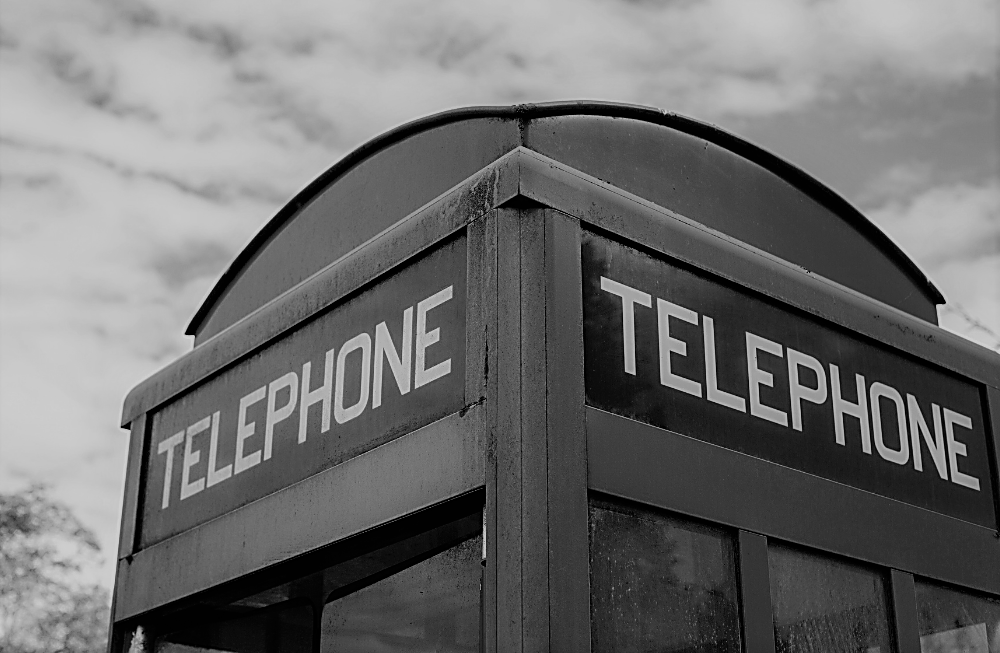
Panty Raid A prank where large groups of college men would invade female dorms and steal their panties.
This was the first college fad since the goldfish swallowing of the 1930s. The first documented incident occurred in 1949 at Augustana College in Illinois, but it was the next incident at the University of Michigan in 1952 that began panty raids across the nation.
Many times the women would open their doors and windows and toss out their undergarments.
These harmless pranks soon saw injuries, and the colleges began penalizing those men involved with suspensions.
Phone Booth Cramming – 1959 -a fad where several young people would enter a phone booth until no more could fit in. The record was set on March 20, 1959, in South Africa, where 25 people were able to squeeze in. Soon after, the fad fazed out.
Slang
- Ankle-biter – A Child
- Back Seat Bingo – Making Out In The Back Seat Of A Car
- Bash – A Party Or To Insult
- Beatnik- Young And Artistic Person Who Rejects The Mores Of Conventional Society
- Blast – A Good Time
- Bug – Bother/Irritate
- Cruisin For A Bruisin – Looking For Trouble
- Fink – Tell On Someone
- Gas (It Was A Gas) – Good Time
- Go Ape – Be Really Mad
- Greaser – A Male That Uses A Lot Of Grease In His Hair
- Party Pooper – A Person Who Is No Fun
- Peachy Keen – Good
- Pedal Pushers – Capri Pants
- Peel Out – Speed Away In A Car
- Round Heels – A Promiscuous Woman
- Split – Leave
- Threads – Clothes
- Wet Rag – A Person Who Dampens Enthusiasm
Pop Culture
- Hula Hoops: Swirling around the waists of young children and adults alike, hula hoops became the embodiment of fun in postwar America.
- Fashion Statements: From the leather jackets that became synonymous with rebellion to the poodle skirts that defined the style of young women, fashion trends reflected the dynamic spirit of the era.
- Dining Innovations: The birth of TV dinners catered to an ever-busy American family, while McDonald’s emerged, reshaping the concept of meals on the go.
- Entertainment Venues: The drive-in movie theater, combining America’s love for automobiles with cinema, became a hallmark of the era’s leisure activities.
These fads and lifestyles signaled a shift in American society, reflecting its evolving values and the quest for identity among the baby boomers carving out their place in the world.
Games/Toys
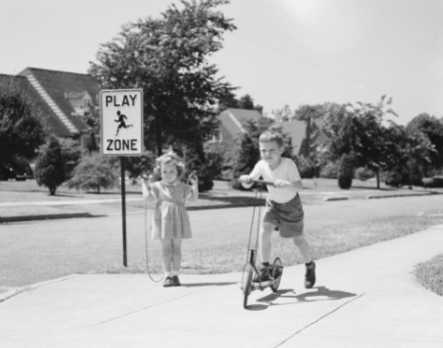
A few of the games we love and play today originated in the 1950s.
- Popular Games Originating in the 1950s Include:
- Perquackey 1955
- Risk 1957
- Yahtzee – 1954
- Some of the Most Popular Toys That Made Their Way Onto the Scene in the 1950s Were:
- Beanies with Propellers – 1947 became popular in the 1950s
- Matchbox Cars – 1953
- Hula Hoop – 1958
- Barbie – 1959
Parents observed a surge in these toys’ popularity as they became household staples during the baby boom years. These items not only defined leisure time for young children but were also reflective of the booming economy and the American dream of the era, underpinning the optimism that characterized the daily lives and cultural landscape of 1950s America.
Final Words
Whether you’re a baby boomer cherishing childhood memories or a young person connecting with American society’s past, the hula hoops and Elvis Presley tunes ignite a sense of nostalgia. Perhaps this look back stirs in you an appreciation for the era’s contribution to the American dream.
If you have any memories of life in the 50s you would like to share, I would love to read them; please comment below.
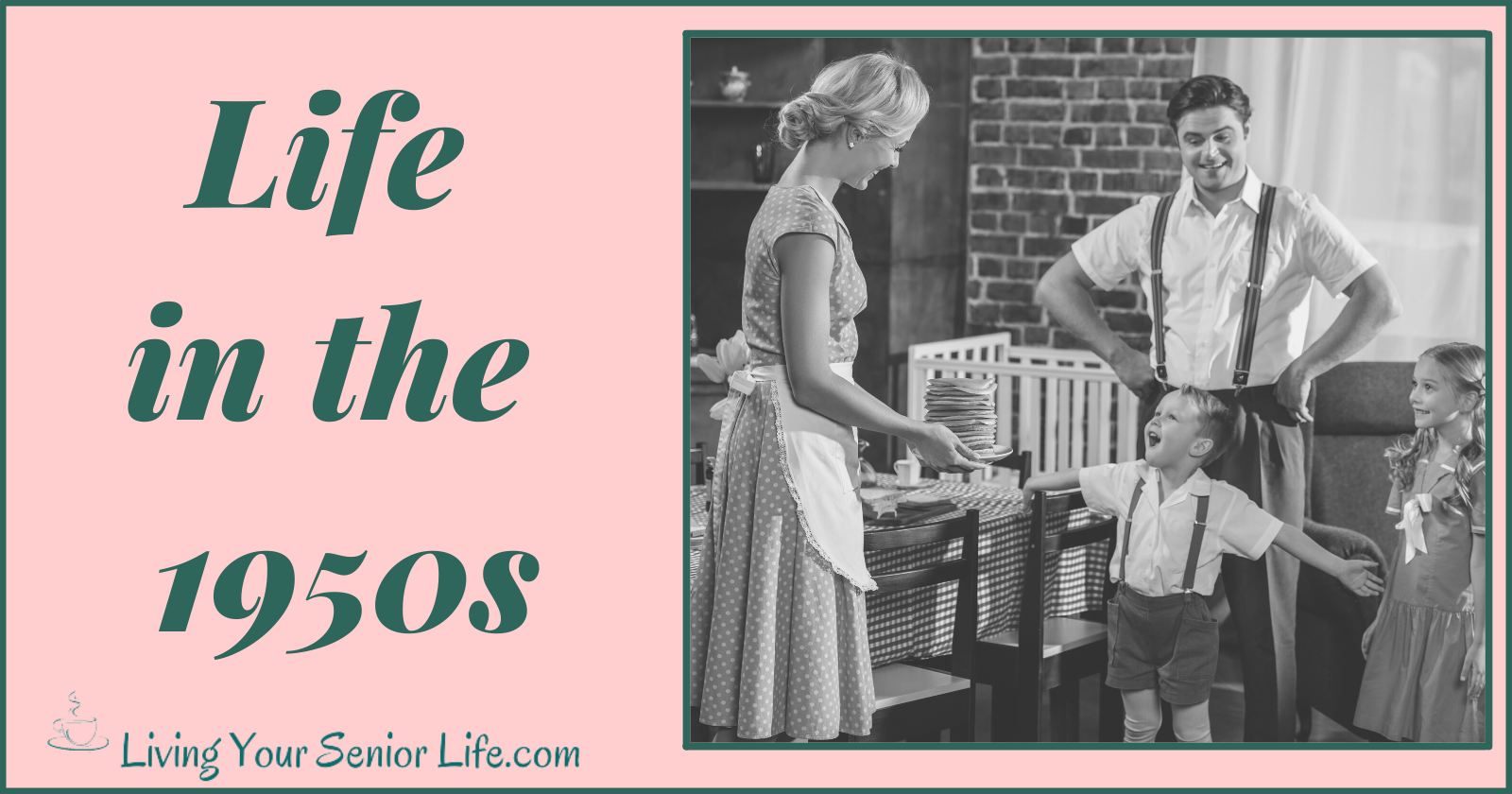




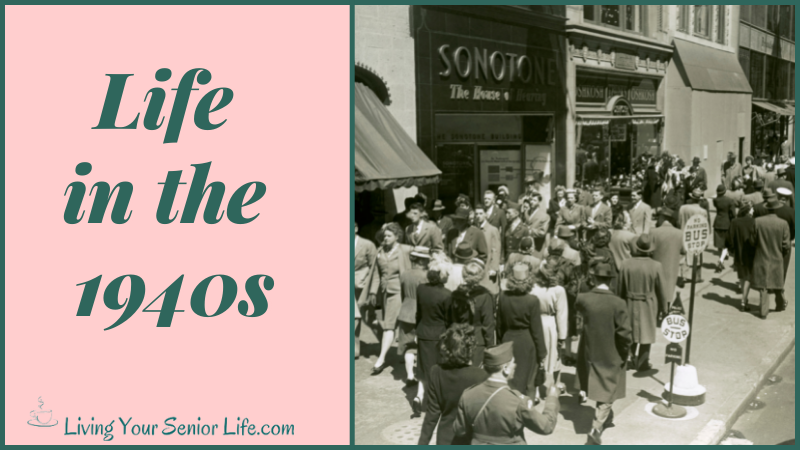







Born late 1940s, played marbles as a kid. Some terms for marbles:
*Shooter” — the marble used to hit other marbles; often a larger diameter.
“Cleary” — clear glass marbles. Came in clear, blue, and light brown.
“Cats-eye” — clear marbles with a “cat’s eye” inside.
“Steely” — a “marble” that was actually a steel ball bearing.
“Aggie” — a marble made from an agate stone.
I saw a white marble that was supposedly made in Rome centuries ago. I don’t know what to call it or if it was real.
Hello! Thank you for sharing your nostalgic memories of playing marbles in the 1950s. It’s always heartwarming to take a trip down memory lane and recall the games and toys that brought joy during our childhoods.
It’s fascinating to hear about the different terms and types of marbles you used to play with. Marbles were such a beloved pastime, and each region often had its own unique names and variations. “Shooter,” “Cleary,” “Cats-eye,” “Steely,” and “Aggie” all evoke a sense of nostalgia and remind us of the rich tapestry of childhood games.
Thank you for sharing your wonderful memories.If you have any more stories or memories to share, please feel free to do so.
I was born in 1950 and my father was an electrical engineer. A big part of our life was television we had the first TV set in our neighborhood before I was five years old and by the 1960s we had a color TV – but also three or four other TVs in our house. My high school history teacher predicted that this would turn out to be a disaster for our young minds
So I guess I would add to your story of the 50s: howdy doody, the wonderful world of color (Walt Disney) even though it was in the 60s, I was on romper room before I was five in North Carolina! My father thought that television was bad for us because the problems in sitcoms got solved in half an hour and made us impatient and intolerant of challenges.
The 1960s also overly influence for me by television: Walter Cronkite, Star Trek, bewitched, I watched a lot of television, and I now think that it influenced my thinking quite a lot more than most things in those decades. I stopped watching television when I was in college and picked it up here and there later on.
Nancy, grew up in the New York metropolitan area
Dear Nancy,
Thank you so much for sharing your personal experiences and insights about life in the 1950s and how television played a significant role in your family’s life. It’s fascinating to hear about your perspective as someone who grew up during that era, especially considering your father’s profession as an electrical engineer.
How exciting it must have been to have the first TV set in your neighborhood and to witness the transition from black and white to color television during the 1960s. Shows like “Howdy Doody” and “The Wonderful World of Color” (Walt Disney) have left lasting memories for many, and it’s great to hear that you were part of the Romper Room experience in North Carolina.
I found your teacher’s prediction about the potential negative impact of television on young minds to be quite interesting. The idea that sitcoms’ quick problem resolution could make us impatient and intolerant of challenges is thought-provoking.
Also, your mention of the 1960s and how television continued to influence your thinking with figures like Walter Cronkite and shows like “Star Trek” and “Bewitched” is a testament to the enduring power of the medium to shape our perceptions and interests.
Thank you for stopping by and adding these rich layers to the story of life in the 1950s, highlighting the impact of television and your personal journey with it.
Debbie
Thank you to all for your input into an era that I can’t get out of my mind and soul. Just reading all of your responses sent chills throughout my body. I grew up in the fabulous 50s and experienced much of the emotional journey as you describe. I married my high school sweetheart in 1963 and remained in a solid marriage until he died in 2017. We courted for 5 1/2 years while he went to university in the US. During that time we wrote 500 letters to each other. After he died I opened the suitcase where we had preserved the letters and the bulk of our early lives in the 50s and 60s tumbled out. I wanted to share a little bit of history and completed writing my memoir, 59 Winters-A Love Story over the past 6 years. I’m in the process of getting a publisher that would be interested in contributing to preservation of the 50s/60s in a real life sentimental, albeit nostalgic journey. Wish me luck!
Again thanks to all for your exciting comments regarding this era.
Jo-Anne
Dear Jo-Anne,
Thank you so much for sharing your deeply touching and personal story. It’s truly incredible to hear about your experiences growing up in the 1950s and the enduring love story you’ve lived. The fact that you and your high school sweetheart preserved 500 letters and mementos from that time is a testament to the enduring romance and nostalgia of that era.
Your memoir, “59 Winters-A Love Story,” sounds like a remarkable journey through the 50s and 60s, and I’m sure it will resonate with many who cherish that period. The preservation of personal stories and experiences from that time is so important, and I wish you the best of luck in finding a publisher who will appreciate and contribute to the preservation of this sentimental and nostalgic era.
Your story is a beautiful reminder of the enduring power of love and the significance of personal histories. Thank you for sharing, and I hope your memoir finds its way into the hearts of many.
Warm regards, Debbie